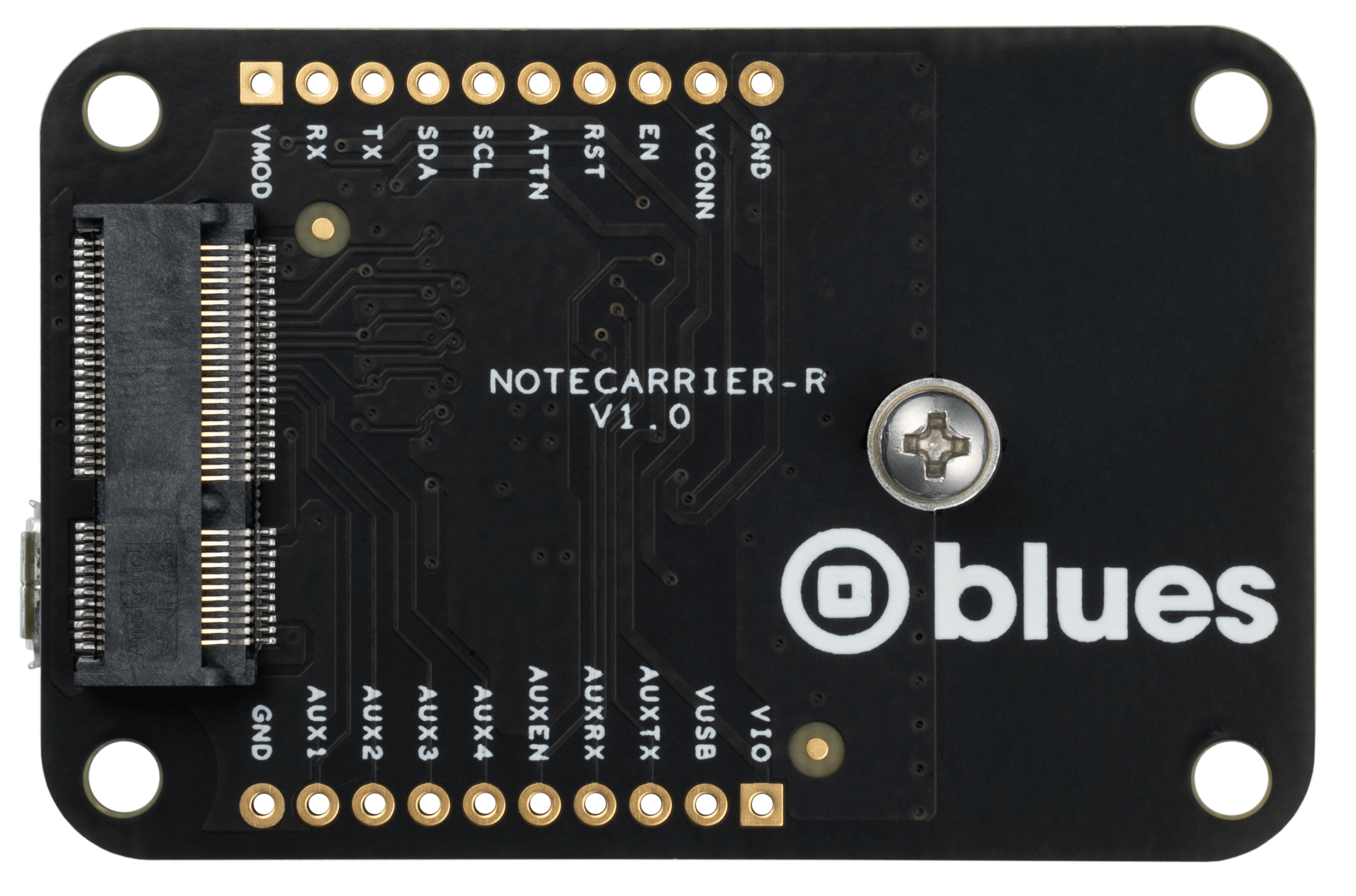The Notecarriers
Notecarriers are companion project accelerator boards designed to make it easy to prototype and deploy IoT solutions with the Notecard.
The bridge between your host and the Notecard
Any MCU or SBC
Regardless of the microcontroller or single-board computer you’re using, there is a compatible Notecarrier for your project.
Fast prototyping (and deployments)
Each Notecarrier model provides an easy connectivity method to your existing IoT solution, whether it’s via header pins for prototyping or castellated edge connectors for embedding in a production solution.
Onboard cellular/Wi-Fi and GPS antennas
Most Notecarrier models come with onboard embedded cellular/Wi-Fi and GPS antennas, eliminating the need for external hookups.
Power options galore
Supporting AA batteries, LiPo, solar, and micro-USB, there are Notecarrier models that support virtually any type (and combination) of power supply.
Meet the Notecarriers
Notecarriers make it easy to prototype and deploy IoT solutions with the Notecard.
-
Notecarrier F
- 24-pin Adafruit Feather breakout header
- Nano-Sim slot for (optional) additional carrier connectivity
- JST connectors for V+, LiPo, and Solar
- Supports Notecard Outboard Firmware Update
- This product requires a Notecard
-
Notecarrier Pi
- Stackable 40-pin Pi-compatible HAT
- Grove I2C port for external peripherals
- Includes U.FL cellular/Wi-Fi antenna (GPS requires U.FL active antenna)
- This product requires a Notecard
-
Notecarrier A
- Onboard cellular/Wi-Fi and GPS antennas
- Two Qwiic ports for connecting I2C peripherals
- JST Connectors for V+, LiPo, and Solar power
- This product requires a Notecard

-
Notecarrier B
- Small form-factor Notecarrier for deployments
- Male headers to access all pins on the Notecard edge connector
- One Qwiic port for connecting I2C peripherals
- This product requires a Notecard

-
Notecarrier R
Easily Integrate the Notecard into your Arduino Portenta H7 or MKR BoardSolution
- Built for Arduino Developers
- Small form-factor for production-ready deployments
- ESLOV (5-pin JST) connector for wire-to-board applications
- Easily power your deployments through a Micro USB connection or with a LiPo battery
- This product requires a Notecard
Which Notecarrier is right for me?
Discover the right Notecarrier for your host, power supply, and deployment stage.

Notecarrier F
Best when using Feather-compatible MCU
103mm x 51mm
Adafruit Feather-compatible
Bring Your Own Antenna
Two Qwiic I2C Ports
LiPo/Solar/V+
Micro USB
External Nano-SIM Socket for Additional Carriers

Notecarrier Pi
Best when using a Raspberry Pi-compatible SBC
56mm x 65mm
Raspberry Pi
External Cellular/Wi-Fi Antenna
One Grove I2C Port
Pi HAT
Micro USB
External Nano-SIM Socket for Additional Carriers

Notecarrier A
Best when prototyping with any other MCU
68mm x 75mm
Any MCU
Embedded Antennas
Two Qwiic I2C Ports
LiPo/Solar/V+
Micro USB
External Nano-SIM Socket for Additional Carriers

Notecarrier B
Best for small form factor deployments
52mm x 46mm
Any MCU
Bring Your Own Antenna
One Qwiic I2C Port
2.5V-5.5V to V+
Micro USB
—
Frequently Asked Questions
The Blues Wireless Notecard and its companion Notecarrier-Pi HAT support virtually any Raspberry Pi-compatible single-board computer (SBC) with a 40-pin male header connector. Some examples of compatible SBCs include the balenaFin, Banana Pi, and the ROCK Pi.
Note that due to the power requirements of the Notecard, some Raspberry Pi 2 and 3 models include a current-limiting fuse that will power-cycle the device when the Notecard’s modem is on and transmitting. To avoid these issues, we recommend using Raspberry Pi 4 devices with the Notecard and Notecarrier Pi HAT.
The Blues Wireless Notecard, combined with the Notecarrier-F, is the easiest way to add cellular connectivity to your MCU-based IoT project. Blues Wireless provides a Feather Starter Kit that includes a Blues Wireless Swan to get you started as quickly as possible. Alternatively, if you are invested in the Raspberry Pi platform, you can get started with the Raspberry Pi Starter Kit.
No! The Blues Wireless Notecard is a small 30mm x 35mm system on module (SoM) that is able to be embedded in any IoT project on its own via its M.2 edge connector.
However, Blues Wireless provides a variety of Notecarrier host boards for easily adding cellular connectivity to a new or existing IoT solution for prototyping purposes. The Notecarrier also provides antennae for both the GPS and cellular capabilities of the Cellular Notecard (and the cellular antenna is also compatible with the Wi-Fi Notecard).
- Notecard: SoM peripheral with a cellular modem, IMU sensor, GPS modem, with an M.2 edge connector.
- Notecarrier: A prototyping board with cellular/Wi-Fi and GPS antennae, used to breakout the pins on the Notecard’s M.2 connector.
- Notehub: A cloud service, used as a backend to connect with the Notecard. Notehub.io securely receives all data and communications created by the Notecard. In turn, Notehub.io can securely sync encrypted data with the cloud application of your choice using VPN tunnels which eliminates the need for traffic to traverse the public Internet.
Learn more about the Notecard Outboard Firmware Update feature here.
We’re making IoT quick and easy.
Start your IoT journey with us!
Subscribe to our newsletter
Expert tips, exciting projects, and IoT insights delivered every month


